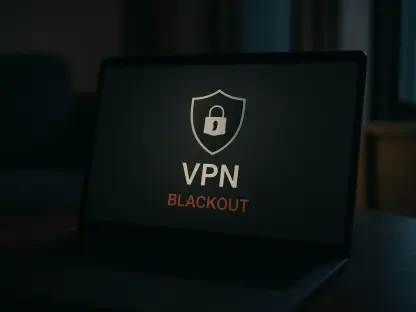Every year, the Black Hat conference transforms the Mandalay Bay conference center in Las Vegas into a crucible of cybersecurity innovation, attracting around 20,000 technology professionals, including developers, engineers, and researchers, all eager to push the boundaries of hacking and network attacks. This high-profile event serves as a unique testing ground not only for the attendees but also for the network operations center (NOC) team, who face the daunting task of maintaining a secure and reliable network under extreme conditions. As detailed in a compelling exploration by technology journalist Rob Pegoraro, the intricate dance between cutting-edge infrastructure and unpredictable human behavior lies at the heart of Black Hat’s network challenges. Through insights from key figures like Neil “Grifter” Wyler, co-lead of the NOC, and James Pope, head of the security operations center (SOC), a vivid picture emerges of technical triumphs constantly tested by human fallibility. The story underscores a critical truth: even in an environment of experts, people remain the most persistent obstacle to flawless security.
Engineering a Robust Network Under Pressure
The technical backbone of Black Hat’s network is a marvel of rapid deployment and high performance, crafted to withstand the intense demands of a uniquely skilled user base. In a matter of days, the NOC team assembles a powerhouse system featuring two 10Gbps circuits, 145 advanced Wi-Fi access points, and strategic partnerships with industry leaders like Cisco Security and Palo Alto Networks. Performance metrics are staggering, with total traffic reaching 462TB and Wi-Fi throughput peaking at 4.2Gbps, outstripping the capabilities of many other major conference networks. This infrastructure isn’t just about raw power; it’s a carefully orchestrated setup designed to ensure seamless connectivity for thousands of attendees engaging in high-stakes activities. The ability to achieve 100% internet availability under such pressure speaks to meticulous planning and engineering expertise, setting a benchmark for what’s possible in temporary network environments.
Beyond the hardware, the real test lies in adapting to the unpredictable nature of Black Hat’s attendees, who often push the network to its limits with experimental hacks and heavy usage. The NOC team must anticipate and respond to spikes in demand while maintaining stability, a feat that requires not just technical know-how but also a deep understanding of the event’s unique dynamics. Impressive as the setup is, it operates in a context where technology alone cannot guarantee success. The article highlights how even the most robust systems are only as strong as the behaviors of those using them, pointing to a recurring theme of human-driven vulnerabilities that no amount of bandwidth can fully mitigate. This tension between engineering excellence and user unpredictability shapes much of the network’s operational story.
Navigating a Distinctive Security Landscape
Black Hat’s security environment stands apart from typical conference settings, demanding a nuanced approach from administrators who must balance tolerance with vigilance. Attendees frequently apply hacking techniques learned from sessions, testing the network in ways that would be unacceptable elsewhere. Unless these actions directly harm others or cross into illegal territory, the NOC and SOC teams often allow such experimentation to continue, fostering an atmosphere of learning and innovation. James Pope notes that while certain boundaries remain non-negotiable, there’s a deliberate leniency in place to encourage exploration, creating a complex dynamic for those tasked with oversight. This permissive stance makes Black Hat a rare space where pushing limits is part of the culture, yet it also heightens the challenge of maintaining order.
This unique security model requires constant discernment to separate harmless tinkering from genuine threats, placing the SOC team in a high-stakes role of interpretation. The need to make split-second decisions about when to intervene adds layers of complexity to their work, as they must weigh educational benefits against potential risks. Unlike standard events where strict rules can be uniformly enforced, Black Hat operates as a microcosm of broader cybersecurity dilemmas, where context and intent are critical factors. The article reveals how this balancing act mirrors real-world challenges in the field, where security professionals must often navigate gray areas rather than clear-cut scenarios. It’s a reminder that technology events of this nature are as much about managing people as they are about managing systems.
Human Vulnerabilities in a High-Tech Arena
Even with a state-of-the-art network, human behavior emerges as the most significant hurdle to security at Black Hat, a theme that resonates throughout the detailed account. A striking example is the prevalence of “panic updates,” where attendees—many of whom are seasoned professionals—rush to patch their devices upon arriving, revealing a surprising lack of preparedness. Neil Wyler points to this trend as a glaring gap in basic security hygiene, one that strains the network with sudden bursts of traffic and exposes vulnerabilities. Such oversights aren’t just minor inconveniences; they create openings for potential exploits in an environment where every weakness can be tested. This behavior underscores a disconnect between expertise and practice, highlighting how human procrastination can undermine even the best technical defenses.
Further compounding the issue are practices like “vibe coding,” where developers lean on AI tools or hastily integrated libraries without rigorous security vetting, as noted by James Pope. Instances of unencrypted data transmission, such as sensitive information being sent in cleartext, illustrate the tangible risks of prioritizing speed over caution. These lapses are not isolated but reflect a broader tendency among even skilled individuals to cut corners under pressure or out of convenience. The article paints a sobering reality: in a community expected to set the standard for cybersecurity, human error remains a pervasive threat that no firewall can fully block. It’s a challenge that extends beyond Black Hat, reflecting industry-wide struggles to align human decision-making with technological safeguards.
The Dual Role of AI in Network Oversight
Artificial intelligence and automation stand as critical tools in managing the complexities of Black Hat’s network, offering efficiency in a high-pressure setting. During the event, AI systems handled over 1,700 incidents automatically, demonstrating their prowess in detecting anomalies and enabling rapid responses to potential issues. From identifying unusual behavior patterns among attendees to streamlining incident reports, these technologies allow the NOC team to oversee a sprawling network with minimal manual intervention. This capability is vital in an environment where threats can emerge at any moment, providing a layer of protection that human monitoring alone could not achieve. The integration of such advanced tools marks a significant step forward in how large-scale events can maintain security and stability.
However, AI’s role is not without complications, as its misuse in other contexts introduces new risks to the cybersecurity landscape. The article points to the trend of developers relying on AI for quick coding solutions, often resulting in insecure applications due to insufficient scrutiny of generated code or external libraries. This double-edged nature of AI—serving as both a defender and a potential source of vulnerability—mirrors broader industry challenges where innovation can outpace caution. While automation strengthens network management at Black Hat, it also serves as a cautionary tale about the need for oversight in how such tools are applied elsewhere. The balance between leveraging AI’s benefits and mitigating its pitfalls remains a critical consideration for the future of cybersecurity.
Reflecting on Progress and Persistent Gaps
Looking back, the efforts of the Black Hat NOC team showcased an extraordinary blend of technical mastery and adaptive strategy in maintaining a network under relentless scrutiny. Their ability to construct a high-performing system from the ground up and sustain 100% uptime amidst intentional attacks was a remarkable achievement. Yet, the persistent shadow of human error—evident in delayed updates, risky coding practices, and incomplete adoption of encryption—cast a sobering light on the limits of technology alone. The nuanced security policies that tolerated experimentation while guarding against harm reflected a deep understanding of the event’s dual role as both a learning hub and a potential risk zone.
Moving forward, the insights from this event point to actionable steps for the cybersecurity community. Prioritizing education on basic security practices, even among experts, could address preventable lapses like unpatched devices. Encouraging stricter vetting in development processes, especially with AI tools, might curb the introduction of new vulnerabilities. Additionally, fostering a culture of empathy, as Wyler advocated, could help bridge the gap between technical solutions and human tendencies. As encryption rates improve, closing the remaining gap with industry standards should be a collective goal, ensuring that awareness translates into consistent action. These steps offer a path to strengthen not just Black Hat’s network but the broader field against ever-evolving threats.









